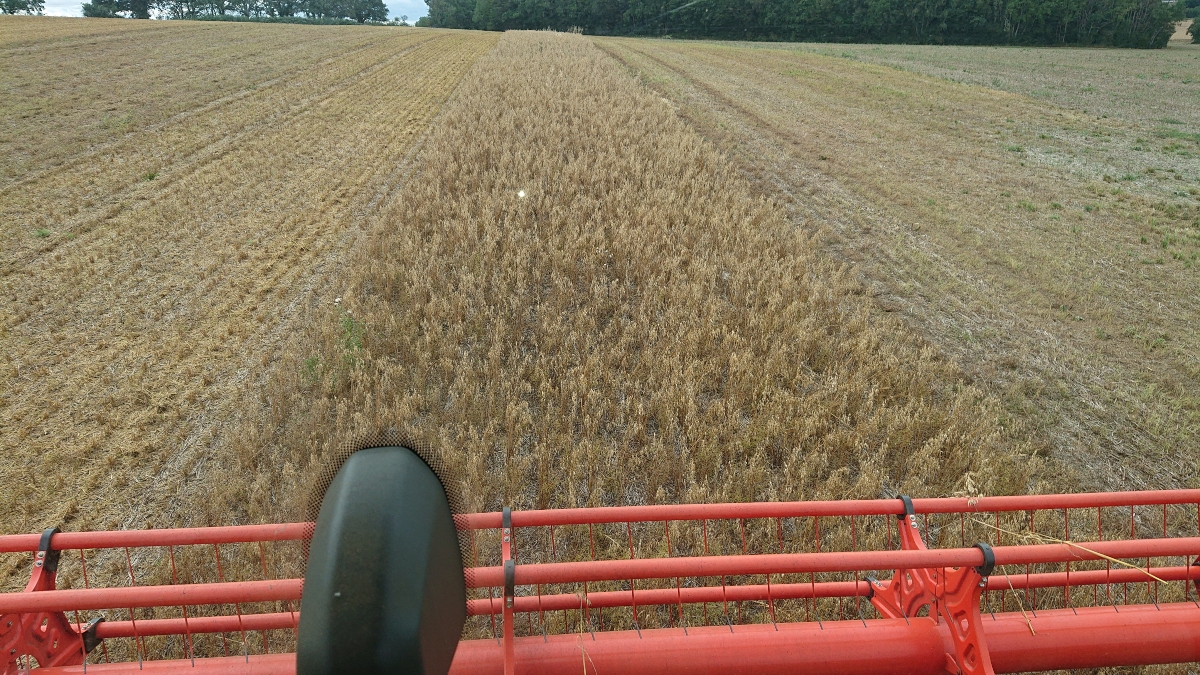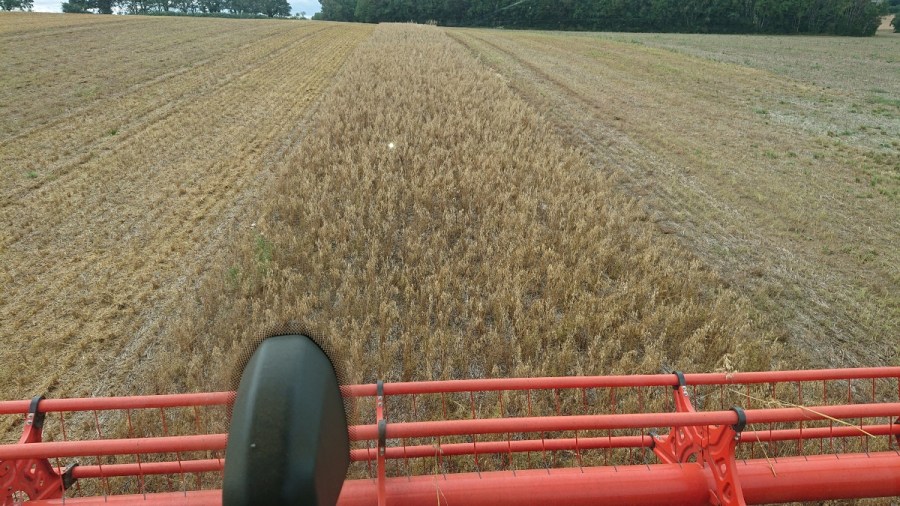
Just how could intercropping reduce nitrogen requirements? Intercropping expert and Kent grower Andy Howard explained at a Wessex Water farm meeting hosted by Dorset farmer John Hawkins.
I never use nitrogen on intercrops, so it is an easy way of omitting nitrogen
By Mike Abram
Intercropping is one potential technique that could be used to reduce reliance on synthetic fertilisers – something which is under scrutiny not just because of the drive towards net zero but also the extremely high cost of fertiliser currently.
Swedish researchers led by Erik Steen Jansen estimated in 2020 that the increased N use efficiency by intercropping cereals and grain legumes could reduce the requirements for synthetic fertilisers by 26% on a global scale.
Intercropping has been one of the key techniques used by Kent farmer and Abacus Agriculture consultant Andy Howard on his quest to reduce all inputs by 50% on his 300ha Bockhanger Farm near Ashford. Alongside winter wheat, which covers about 40% of his arable area, he has a varied rotation including spring beans, winter barley, herbage seeds and various pulse-oat intercrops.
The intercrops usually make up around 25-30% of his rotation, although that might slightly increase this season with the high price of nitrogen, and only one load of ammonium nitrate purchased by mid-October.
“That is focusing my mind,” he says. “I never use nitrogen on intercrops, so it is an easy way of omitting nitrogen. I’m likely to do more than I had planned but not quite sure what yet.”
Successfully incorporating intercropping into a rotation isn’t straightforward, he acknowledges, but along with other practice changes it has led to a 40% reduction in nitrogen use on the farm. Fungicides have also been reduced by his target 50%, insecticides mostly eliminated, leaving only herbicides close to more conventional usage.
At its simplest intercropping is growing two or more crops together and harvesting at least one. It has several alternative names – companion, pasture or relay cropping, for example – and is by no means a new technique. Native Americans were growing the “three sisters” maize, beans and squash over 5000 years ago – a practice still used on allotments all over the country.
“Intercropping tries to mimic Mother Nature, by having lots of diversity not just above and below ground, but over time too. It will never be as good as Mother Nature but that’s what the aim is.
“The principles are the same as for cover crops – just you’re taking at least one crop to harvest.”
One of his main intercrops is beans and oats.
“When we grow beans and oats together and people see these bright green oats with no nitrogen applied, they think the legume is giving all its nitrogen to the cereal. But that’s not true. Nitrogen fixation is a very energy intensive process, even for plants, and they don’t do it unless they have to. If you put nitrogen on a bean crop, they won’t nodulate, they get lazy.”
Legumes actually give up very little of their nitrogen, with research figures suggesting there is just 6kgN/ha direct transfer between pea and barley crops. “But as we saw last year, our oats with a few beans didn’t need any nitrogen. I don’t think we really know what is happening. My guess is you are improving the microbiome with the roots, getting different microbes excited by having two or more crops together.
“One theory is that a waste product of nitrogen fixation, hydrogen gas, excites the microbiome, making a lot of other nutrients available and increasing the growth of the companion rather than the nitrogen itself.
“I haven’t found an intercrop that has needed any nitrogen on yet.”
Oats has become the go to cereal in Andy’s intercrops as it maintains a break from wheat, which isn’t really the case with barley, while also being competitive against weeds. “They’re a little later maturing than barley and need very little looking after – a good low input option.”
It helps if your drill is capable of drilling seed separately at different depths, but isn’t vital, Andy says. “If you don’t have a drill that’s capable of doing that, you can just mix the seed in the hopper as long as the seed depth isn’t too different.”
Being able to separate seed after harvest is a key requirement if you are planning to sell the output. “Obviously it doesn’t matter if you’re growing it for animal feed, but it can be a big headache if you get it wrong.”
Andy’s separation system is in an old cattle shed. “We have a trailer either side of a rotary cleaner at the top. The harvested crop goes in as one, and the separated crops go out into the trailers. It’s not fast, an extra cost and tends to be a winter job but we also use the system to clean our own seed.”
Beans and oats – dubbed “boats” – as an intercrop has worked well on Andy’s farm for the past four seasons, after a 15% overall yield increase in a trial in year one persuaded him to try on a field scale the following year. He’s aiming for 6t/ha combined yield with 3-4t/ha of beans, and 2-3t/ha of oats.
“You will lose some bean yield when you intercrop oats, so we’re trying to reduce that.
“My idea last year was to have oats only every other row. Unfortunately, it didn’t quite work with the drill, but I think it could reduce the amount of bean yield you lose. You don’t need many oats to get a good yield of oats.”
Overall, the combination is producing more output off the same area of land as a monocrop, he says. “We grow them for virtually no cost: just seed, one herbicide and sometimes one fungicide. If it’s wet it’s for chocolate spot in the beans, if it is dry for rust on both, but mostly I don’t think we need it.
“We’re finding it helps with risk management – we always get a crop even if something goes wrong with the weather, and it’s better than spring beans alone, which we find is quite hit and miss.”
‘Boats’ gross margins have been from £40/ha to £200/ha higher over the past three seasons compared with beans alone, depending on the year, while yield consistency across the field has improved.
Peas and spring oilseed rape grown together – dubbed “peola” – were successful to begin with, but Andy gave up growing them two years ago. “I just couldn’t get the spring oilseed rape to grow. It would come up, look at you and then disappear.”
However, with prices of oilseed rape at over £500/t this autumn, he is considering whether to give it another go, he admits. “I might be stupid enough to try again – it’s easy to separate, herbicides are not too difficult, and keeps the peas off the ground.”
Trialled as part of the EU Horizon 2020 DIVERSify (Designing InnoVative plant teams for Ecosystem Resilience and agricultural Sustainability) project peas and oats highlighted the ability of an intercrop to reduce herbicide costs.
“Peas are notoriously weedy, and the oats do mean you get lower numbers of weeds. Wherever we had oats we had an £80/ha lower herbicide cost. In a weedy season, like last year, the solo crops of peas or beans had a lot of weeds, but with the intercrop, while there’s still weeds there, it was a lot less of an issue.”
But harvest dates can be tricky, he acknowledges. “This year the oats were not ready, but we are growing marrowfat peas which come early. Some people have got on well with peas and oats, but it hasn’t quite worked here. I don’t know whether it is the peas ripen even earlier in the southeast with the heat. Variety is the key – you need a later maturing pea, but the choice of varieties is quite narrow.”
Intercropping for niche crops with significant agronomic challenges can make a real difference, Andy says. Lentils – grown for Hodmedods – are grown with oats to avoid trying to combine the lentils on the ground.
“In a 2020 trial we found the lowest rate of oats of 30 plants / sqm didn’t affect the lentil yield but made a significant difference to lodging.
“We actually had to combine the field twice when we didn’t have a companion, you go one way and then the other to maximise what you harvest. As a high value crop you don’t want to leave any in the field.”
This combination was found by chance in 2018, when during a wet, cold spring Andy’s linseed crop was being hammered by flax flea beetle, despite being sprayed three times with insecticide. “I was walking across the field and there was a patch of wild oats where the linseed was perfectly fine.
“The following year we did a trial. The oats are just a companion, and we take out the oats as soon as possible once the linseed is established to stop the competition issue.
“Where there were no oats with the linseed there was a lot more pest damage, and a much thinner crop. We also saw with a higher number of oats faster growth of the linseed, which might be one reason why it got away.
“That resulted in a 20% yield increase just by having the oats there for six weeks. It probably won’t work in every year, and if you get a year of low flea beetle attack you probably won’t see any difference, but it’s cheap and worked well for us a few times.”
Crop mixer tool
A tool developed as part of the DIVERSify project provides information about crop combinations, varieties and management strategies in different regions and cropping systems.
Within CropMIXER you initially select whether you’re interested in grain yield or biomass, the growing season (spring or autumn), farming system and primary and / or secondary crops of interest.
Assuming there are trials datasets meeting your criteria, data summaries of monocrop yields versus mixture will be shown, along with average weed cover. More information about the individual trials is available by drilling down in the tool.
Andy’s 11 characteristics and considerations for a good intercrop combination
- Different rooting depths – will help minimise competition underground, and help explore different parts of the soil for nutrients and water
- Mycorrhizal association – brassicas like oilseed rape don’t associate with mycorrhizal fungi, so growing it with a crop, such as a legume or linseed that does will help keep the network alive.
- Complementary root exudates – some plants will produce root exudates that will stop other plants growing, which need to be avoided
- Different nutritional needs – cereals and legumes are a classic combination with legumes producing its own nitrogen and are good at releasing phosphorus
- Different plant species – brings diversity
- Similar planting dates – difficult to plant at different dates unless you’re relay cropping
- Different canopy architecture – avoid competition above ground
- Different pests and disease – intercropping usually reduces pest and diseases, and helps spread risks
- Availability of pesticides – intercropping will restrict availability, especially herbicides. Don’t make blackgrass worse and be careful what you use and when.
- Similar harvesting date – harvesting dates do converge but there is a limit to how much
- Different grain sizes – key if you want to separate after harvest
Andy Howard was speaking at a Wessex Water organised farm meeting in Dorset.




